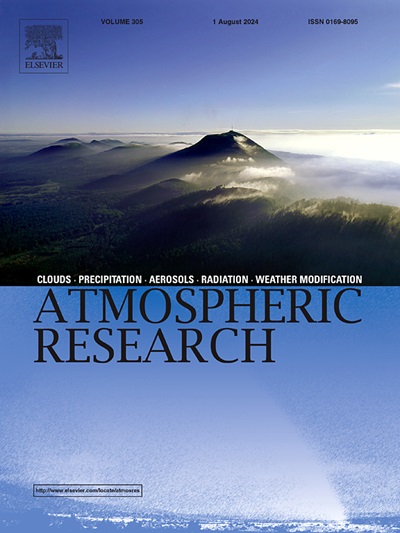Interdecadal reversal in the relationship between Arctic sea ice and the Tibetan Plateau temperature over the past century
IF 4.4
2区 地球科学
Q1 METEOROLOGY & ATMOSPHERIC SCIENCES
引用次数: 0
Abstract
Changes in Arctic sea ice have been shown to affect the climatic variability of the Tibetan Plateau (TP), but it remains unclear whether this Arctic-TP link has been stable over the past century. Using multiple reanalysis datasets (1900–2021), we found an interdecadal reversal in the relationship between winter Barents-Kara Sea ice concentration (BKSIC) and TP surface air temperature (TPSAT). In response to BKSIC loss, an out-of-phase pattern of “warm Arctic-cold TP” occurred during 1950–1975 (P1), while an in-phase pattern of “warm Arctic-warm TP” occurred during 1985–2021 (P2). The reversal of the BKSIC-TPSAT link is associated with changes in the position and strength of the subpolar and subtropical jet streams and quasi-stationary Rossby waves. During P1, the TPSAT was influenced by two distinct zonally oriented wave trains, associated with sea ice loss over the Greenland-Barents Kara Seas, the negative phase of the Atlantic Multidecadal Oscillation (AMO), and the positive phase of the Arctic Oscillation (AO). The north branch of the wave train propagates eastward along the intensified subpolar jet stream, while the south branch of the wave train originated from the North Atlantic and propagates eastward through the subtropical jet stream into the southern TP. In contrast, during P2, prominent BKSIC loss with positive AMO leads to a weakened subpolar jet stream, which favors the meridional propagation of the wave train into the southern TP. This study highlights the potential role of BKSIC in driving differing TP atmospheric thermal conditions in the context of distinct AMO phases.
近百年来北极海冰与青藏高原温度关系的年代际逆转
北极海冰的变化已被证明会影响青藏高原(TP)的气候变率,但在过去的一个世纪里,这种北极与TP的联系是否稳定尚不清楚。利用多个再分析数据集(1900-2021),我们发现冬季巴伦支-喀拉海冰浓度(BKSIC)与TP地表气温(TPSAT)之间的关系呈年代际反转。作为对BKSIC损失的响应,在1950-1975年期间出现了“暖北极-冷TP”的非相位模式(P1),而在1985-2021年期间出现了“暖北极-暖TP”的相位模式(P2)。BKSIC-TPSAT链路的逆转与次极和副热带急流和准静止罗斯比波的位置和强度变化有关。在P1期间,TPSAT受到两个不同的纬向波列的影响,这两个波列与格陵兰-巴伦支卡拉海的海冰损失、大西洋多年代际涛动(AMO)的负相和北极涛动(AO)的正相有关。北支波列沿增强的次极急流向东传播,南支波列发源于北大西洋,经副热带急流向东传播进入南太平洋。相反,在P2期间,BKSIC的显著损失和正AMO导致了一个减弱的次极急流,这有利于波列经向传播到南太平洋。本研究强调了BKSIC在不同AMO相背景下驱动不同TP大气热条件的潜在作用。
本文章由计算机程序翻译,如有差异,请以英文原文为准。
求助全文
约1分钟内获得全文
求助全文
来源期刊

Atmospheric Research
地学-气象与大气科学
CiteScore
9.40
自引率
10.90%
发文量
460
审稿时长
47 days
期刊介绍:
The journal publishes scientific papers (research papers, review articles, letters and notes) dealing with the part of the atmosphere where meteorological events occur. Attention is given to all processes extending from the earth surface to the tropopause, but special emphasis continues to be devoted to the physics of clouds, mesoscale meteorology and air pollution, i.e. atmospheric aerosols; microphysical processes; cloud dynamics and thermodynamics; numerical simulation, climatology, climate change and weather modification.
 求助内容:
求助内容: 应助结果提醒方式:
应助结果提醒方式:


